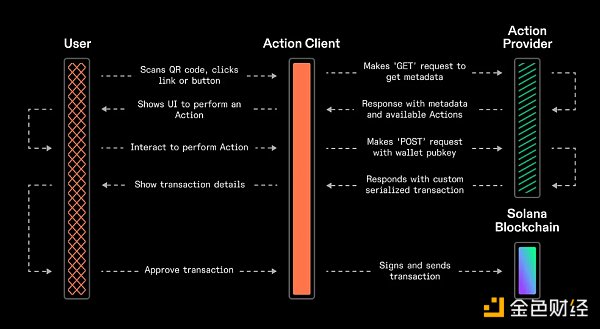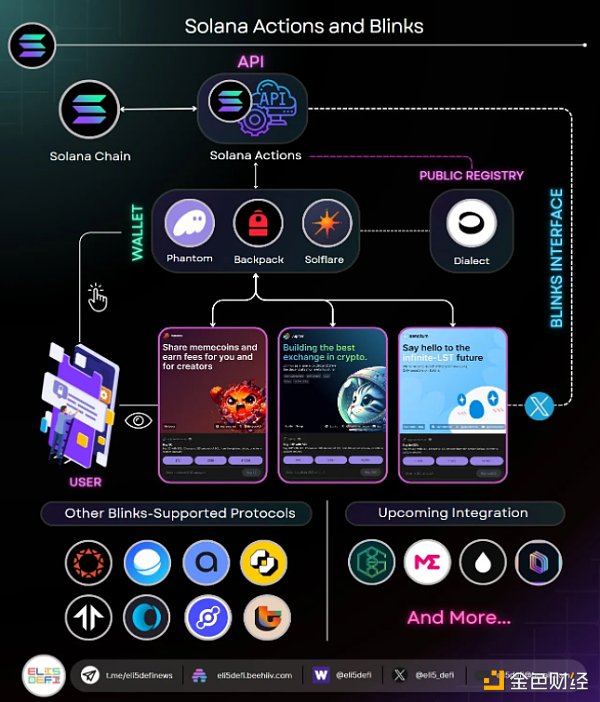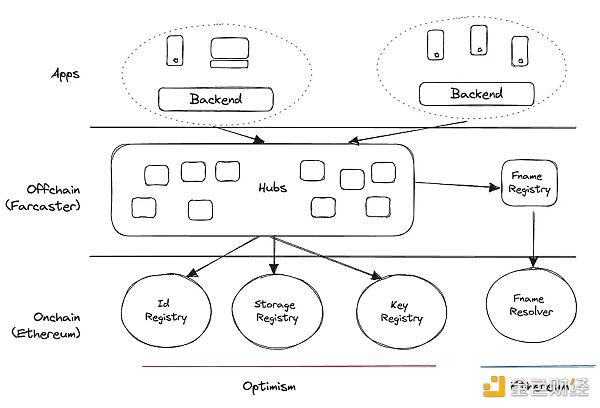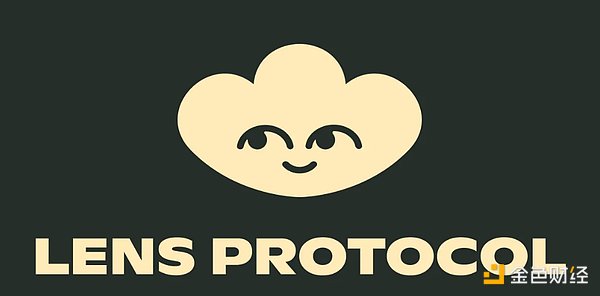Author: YB; Compiler: Vernacular Blockchain
Recently, Solana and Dialect jointly launched the new Solana concept "Actions and Blinks", which implements one-click operation functions such as exchange, voting, donation, and minting through browser extensions. Actions simplifies the execution of various operations and transactions, while Blinks ensures network consensus and consistency through time synchronization and sequential records. The combination of the two enables Solana to provide a high-performance, low-latency blockchain experience. The development of Blinks requires the support of Web2 applications, which brings up issues of trust, compatibility, and cooperation between Web2 and Web3. Compared with Farcaster and Lens Protocol, Actions and Blinks rely more on Web2 applications to obtain traffic, while the latter rely more on on-chain security.
1. How Actions and Blinks work

1) Actions (Solana Actions)
According to the official definition: Solana Actions is a standardized API that returns transactions on the Solana blockchain. These transactions can be previewed, signed, and sent in a variety of environments, including QR codes, buttons + widgets, and websites on the Internet.
Actions can be simply understood as transactions waiting to be signed. Further expanding, Actions are an abstract description of the transaction processing mechanism in the Solana network, covering a variety of tasks such as transaction processing, contract execution, and data manipulation. Users can send transactions through Actions, including token transfers and purchases of digital assets. Developers use Actions to call and execute smart contracts to implement complex on-chain logic.
Solana handles these tasks through "Transactions", each of which consists of a series of instructions executed between specific accounts. Through parallel processing and the Gulf Stream protocol, Solana forwards transactions to validators in advance to reduce confirmation delays. Through a fine-grained locking mechanism, Solana can process a large number of non-conflicting transactions at the same time, greatly improving system throughput. Solana uses Runtime to execute transactions and smart contract instructions, ensuring the correctness of transaction inputs, outputs, and states during execution.
After the initial execution, the transaction waits for block confirmation. Once a majority of validators agree on a block, the transaction is considered final. Solana can process thousands of transactions per second with confirmation times as low as 400 milliseconds. Thanks to the Pipeline and Gulf Stream mechanisms, the network's throughput and performance are further improved.
Actions are more than just tasks or operations, they can be transactions, contract executions, or data processing. These actions are similar to transactions or contract calls in other blockchains, but Solana's Actions have unique advantages:
Efficient processing: Solana has designed an efficient way to process Actions, making them execute quickly in large-scale networks.
Low latency: Solana's high-performance architecture ensures that Actions have very low processing latency, supporting high-frequency transactions and applications.
Flexibility: Actions can perform a variety of complex operations, including smart contract calls and data storage/retrieval (see the extended link for more details).
2) Blinks (Blockchain Links)
According to the official definition: Blinks can convert any Solana Action into a shareable, metadata-rich link. Blinks enables clients that support Actions (browser extension wallets, robots) to display more features to users. On the website, Blinks can immediately trigger a transaction preview in the wallet without redirecting to a decentralized application; in Discord, robots can expand Blinks into a set of interactive buttons. This enables any web interface that displays a URL to achieve on-chain interaction.
In short, Solana Blinks converts Solana Actions into shareable links (similar to HTTP). By enabling related features in supported wallets (such as Phantom, Backpack, and Solflare), websites and social media can become places for on-chain transactions, allowing any website with a URL to directly initiate Solana transactions.
In summary, although Solana Actions and Blinks are permissionless protocols/standards, they still require client applications and wallets to ultimately help users sign transactions, compared to intent statement solvers.
The direct goal of Actions and Blinks is to "HTTP link" Solana's on-chain operations and parse them into Web2 applications such as Twitter.

2. Application of decentralized social protocols on Ethereum
1) Farcaster Protocol
Farcaster is a decentralized social graph protocol based on Ethereum and Optimism, enabling applications to interconnect through decentralized technologies such as blockchain, P2P networks and distributed ledgers. This allows users to seamlessly migrate and share content between different platforms without relying on a single centralized entity. Its open graph protocol (automatically extracts link content from social network posts and injects interactive functions) enables user-shared content to be automatically extracted and converted into interactive applications.
Decentralized network: Farcaster relies on a decentralized network, avoiding the single point of failure problem of centralized servers common in traditional social networks. It uses distributed ledger technology to ensure the security and transparency of data.
Public key cryptography: Each Farcaster user has a pair of public and private keys. The public key is used to identify the user, while the private key is used to sign their operations. This approach ensures the privacy and security of user data.
Data portability: User data is stored in a decentralized storage system rather than a single server. This gives users full control over their data and the ability to migrate between different applications.
Verifiable identity: Through public key cryptography, Farcaster ensures that the identity of each user is verifiable. Users can prove control of their accounts by signing operations.
Decentralized Identifiers (DIDs): Farcaster uses decentralized identifiers (DIDs) to identify users and content. DIDs are based on public key cryptography and are highly secure and immutable.
Data consistency: To ensure data consistency on the network, Farcaster uses a consensus mechanism similar to blockchain (with "posts" as nodes). This mechanism ensures that all nodes agree on user data and operations, maintaining data integrity and consistency.
Decentralized Applications: Farcaster provides a development platform that allows developers to build and deploy decentralized applications (DApps). These applications can be seamlessly integrated into the Farcaster network to provide users with a variety of functions and services.
Security and Privacy: Farcaster emphasizes the privacy and security of user data. All data transmission and storage are encrypted, and users can choose to make content public or private.
In Farcaster's new feature Frames (different Frames integrate Farcaster and run independently), users can turn "casts" (similar to posts, including text, images, videos and links) into interactive applications. These contents are stored in the decentralized network, ensuring their permanence and immutability. Each post has a unique identifier when it is published, making it traceable, and the user's identity is verified through a decentralized authentication system. As a decentralized social protocol, Farcaster's client can be seamlessly integrated with Frames.
2) Main Principles

The Farcaster protocol is divided into three main layers: identity layer, data layer (Hubs) and application layer. Each layer has specific functions and roles.
A. Identity layer
Function: Responsible for managing and verifying user identities; providing decentralized identity authentication to ensure the uniqueness and security of user identities. It includes four registries: ID Registry, Fname, Key Registry and Storage Registry (detailed description in reference link 1).
Technical principle: Use decentralized identifiers (DIDs) based on public key cryptography. Each user has a unique DID to identify and verify their identity. The use of public and private key pairs ensures that only the user can control and manage their identity information. The identity layer ensures seamless migration and authentication between different applications and services.
B. Data Layer — Hubs
Function: Responsible for storing and managing user-generated data, providing a decentralized data storage system to ensure the security, integrity and accessibility of data.
Technical principle: Hubs are decentralized data storage nodes distributed in the network. Each Hub acts as an independent storage unit, responsible for storing and managing a portion of the data. The data is distributed on each Hub and protected by encryption technology. The data layer ensures high availability and scalability of the data, allowing users to access and migrate their data at any time.
C. Application Layer
Function: Provides a platform for developing and deploying decentralized applications (DApps), supporting various application scenarios such as social networking, content publishing, and messaging.
Technical principle: Developers can use the APIs and tools provided by Farcaster to build and deploy decentralized applications. The application layer is seamlessly integrated with the identity layer and data layer to ensure identity authentication and data management during application use. Decentralized applications run on decentralized networks and do not rely on centralized servers, thereby enhancing the reliability and security of applications.
3) Summary
A. Solana's Actions & Blinks
Solana's Actions and Blinks are designed to connect traffic channels for Web2 applications. The direct impacts are as follows:
User perspective: Simplifies the transaction process, but increases the risk of funds being stolen.
Solana perspective: Greatly enhances the cross-border traffic effect, but faces compatibility and support challenges under Web2's censorship system.
In Solana's broad ecosystem, future developments such as Layer2, SVM, and mobile operating systems may further enhance these features.
B. Ethereum's Farcaster Protocol
Compared with Solana's strategy, Ethereum's Farcaster protocol weakens Web2 traffic integration and enhances overall censorship resistance and security. The Farcaster + EVM model is more in line with the native concept of Web3.
4) Lens Protocol

Lens Protocol is another decentralized social graph protocol designed to give users full control over their social data and content. Through Lens Protocol, users can create, own and manage their social graphs and migrate seamlessly between different applications and platforms. The protocol uses NFTs to represent users' social graphs and content, ensuring the uniqueness and security of the data. As protocols on Ethereum, Lens Protocol has some similarities and differences with Farcaster:
A. Similarities:
User control: In both protocols, users have full control over their data and content.
Authentication: Both use decentralized identifiers (DIDs) and encryption technology to ensure the security and uniqueness of user identities.
B. Differences:
Technical architecture:
Farcaster: Based on Ethereum (L1), it is divided into an identity layer for managing user identities, a data layer (Hubs) for decentralized storage nodes, and an application layer that provides a DApps development platform, using offline Hubs for data dissemination.
Lens Protocol: Based on Polygon (L2), it uses NFT to represent the user's social graph and content. All activities are stored in the user's wallet, emphasizing the ownership and portability of data.
Verification and Data Management:
Farcaster: Uses distributed storage nodes (Hubs) to manage data, ensuring security and high availability, updates handles once a year and reaches consensus through delta graph.
Lens Protocol: Personal data archive NFT ensures the uniqueness and security of data without the need for updates.
Application Ecosystem:
Farcaster: Provides a comprehensive DApps development platform that is seamlessly integrated with its identity and data layer.
Lens Protocol: Focuses on the portability of user social graphs and content, supporting seamless switching between different platforms and applications.
Through this comparison, we can see that Farcaster and Lens Protocol have similarities in user control and authentication, but significant differences in data storage and ecosystem. Farcaster emphasizes layered structure and decentralized storage, while Lens Protocol highlights the use of NFT to achieve data portability and ownership.
3. Which protocol can be the first to achieve large-scale application?
Through the above analysis, the three protocols each have their own advantages and challenges.
Solana, with its high performance and ability to transform any website or application into a cryptocurrency transaction gateway, quickly gained attention by leveraging social media platforms and using Blinks. However, its reliance on Web2 brings a trade-off between traffic and security.
Founded in 2022, Lens Protocol uses its modular design and on-chain storage to provide good scalability and transparency, capturing early market opportunities, but may face challenges in cost, scalability, and market FOMO sentiment.
Farcaster's advantage is that its design is closest to Web3 principles and provides the highest degree of decentralization. However, this also brings challenges in technology iteration and user management.
 JinseFinance
JinseFinance
 JinseFinance
JinseFinance JinseFinance
JinseFinance JinseFinance
JinseFinance JinseFinance
JinseFinance JinseFinance
JinseFinance JinseFinance
JinseFinance Nulltx
Nulltx Others
Others Bitcoinist
Bitcoinist Nulltx
Nulltx